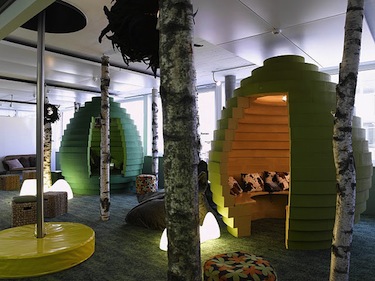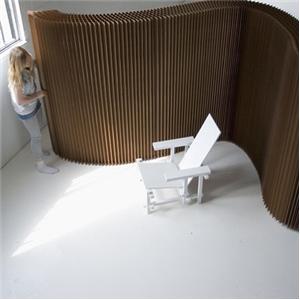Productivity And Collaboration In Person
Next post: Productivity And Collaboration Via Distributed Working
Previous post: Fail Proudly
 a funky, creative space in Google’s Zurich office
a funky, creative space in Google’s Zurich office
The physical workspace is one of the most ignored (yet most important) factors in creating a productive organisation. I’ve been consulting with a company recently who are very focussed on addressing the limitations of their current office space. This got me thinking…
Productivity - Variety Is The Spice Of Life
As a freelancer, whilst I visit the locations of my clients frequently, I am often working at home; planning workshops, doing research, writing this blog.
“So,” I asked myself, “what is my most productive environment?”
I realised that there wasn’t one true answer. In fact, the most productive thing for me is to change locations throughout the day. How often I change and where I go is based on a combination of the work I’m doing and the mood I’m in.
At the moment, my working structure looks a bit like this…
- Reading books/papers: sitting outside, enjoying fresh air and sunshine (luckily for me it’s always sunny in California)
- Engaging with people on social networks on my iPad: on a big, comfy, purple chaise, where I feel relaxed and social
- Writing my blog: wherever I am, using Evernote on any of my devices - the write-up takes place at my desk
- Thinking about new improv exercises: on my bed, with my eyes closed, visualising how it might play out
- Brainstorming with other people: often takes place in a cafe, the energy of all the other people buzzing around us
Open-Plan For Collaboration … Or Is There Something Better?
Having been an office worker-bee in the past, one of the things I felt strongly about was having somewhere to which I could ‘escape from my desk’.
My office back then was open-plan and probably the least productive place I could have been. Open-plan offices are often favoured by companies looking to save some money. More employees can be crammed into a smaller space.
Beyond potential economies, however, there are also supposed communication benefits. The idea is that open spaces foster more communication between employees and increase their sense of community. However, a recent study based on a survey of over 42,000 US office workers in 303 office buildings finds no evidence to support this whatsoever. This study (and others) lead us to understand that open-plan offices are not the best places for many of us.
It all comes down to noise levels and lack of privacy. If someone else is speaking, your ‘auditory bandwidth’ is full and it becomes very hard to listen to the voice in your head that is helping you write the email, the blog or (worse still) the code. For people in technical positions such as developers, an open-plan office can be a real killer.
I’ve never been convinced that huge open-plan offices are the best environments. In fact, those environments breed headphones not productivity and so take us further from the idea of creative community.
I think it would be wonderful for a desk to be a place where productivity and brilliant work emerged naturally. However, for this to be true for me, I’d have to have variation. Perhaps we should all consider whether we’re ‘chained’ to our desks or whether we can find / create opportunities to get a change of perspective.
For most people, their workspace options are dictated by their company. For the lucky few, working at places such as Google, Pixar and Innocent, their offices have been designed around happiness and productivity.
Spaces Designed For Actual People, Not Simply For Workers
 Recent discussions on these topics have led me to conclude that the best choices companies could be making revolve around a deep understanding of their people, their culture and the type of work involved.
Recent discussions on these topics have led me to conclude that the best choices companies could be making revolve around a deep understanding of their people, their culture and the type of work involved.
Businesses should think seriously about creating more social spaces, more flexible meeting spaces and purpose-built quiet areas.
Shopify make for a great example here. At Shopify, you work in ‘pods’, which are rooms of the 6-8 people you work closely with on a day-to-day basis. The pods shoot off from a central hallway loop. On the outside of the loop are the pods, and on the inside are small private meeting rooms and conference rooms. This style of layout self-evidently allows for greater privacy and focus through reduced distraction. That said, it seems to me that a critical requirement of this approach is to remember to create multiple ways for teams to interact with each other outside of their ‘pods’ to prevent divisiveness and to help the spirit of collaboration thrive.
Another cute idea comes from the good people at Molo - the ‘softwall’ (pictured). The ability to create new spaces on the fly is a sure winner in the race to keep workplaces varied and interesting.
And Then … There’s Always Improv
Whether or not you’re lucky enough to have the option of changing/rearranging your office space, you can always look at other ways to build the spirit of collaboration. Improvisers are known to be excellent collaborators. One of the reasons I love using improv as a training tool is that it always yields great results in teams looking to supercharge their spirit of collaboration.
As a Recruiting Manager said to me at Riot Games, their improv course “challenged the team to work beyond their comfort zone and really helped us to work much more collaboratively”.
For more inspiring offices, check this out.
Next post: Productivity And Collaboration Via Distributed Working
Previous post: Fail Proudly